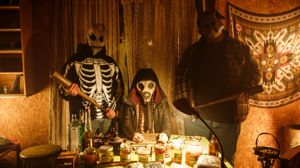I decided to see Rhymes for Young Ghouls based solely on the above image in the Toronto International Film Festival programming guide. Those three masked and costumed figures really piqued my interest in your story about residential schools. But this being your first feature film, I hadn't the faintest idea what to expect. And after leaving the theatre, I was just as perplexed. It wasn't just the emotionally charged plot that left me needing some serious quiet time. It took me a while to actually figure your film out. I didn't quite know what to make of this coming-of-age/fantasy/horror/mythology/history/nursery tale. After all, it skips seamlessly between moments of levity to moments so brutal the gasps coming from the audience were some of the strongest reactions I've ever seen towards a film.
On the Red Crow reservation in 1976, Mi'gmaq teen Aila (Devery Jacobs) holds her family's livelihood and utter existence in her hands. She's running her uncle's drug business and bribing Popper, a chillingly sadistic Indian agent (Mark Anthony Krupa), to keep herself, her brother, and her friends out of residential school. When Aila's father, Jacob (Glen Gould) is taken to the school to be beaten and tortured by Popper, Aila and her friends plan to break into the building, rescue Jacob, and take back a large sum of stolen money. The ensuing fallout sends the film hurtling towards a frantic, devastating climax from which it took me a good few hours to recover.
After my lungs had descended safely from my throat, I could appreciate the balance you struck between the film's various generic and stylistic conventions. My companion was a little put off by the more 'over the top' aspects, like the zombies and, in his words, "absurdly villainous" Popper. But the over-the-top-ness never pulled me away from the characters' very real trauma and tragedy. You use an animated sequence to form a dystopic retelling of an Indian myth, and zombies to represent the collective mental and emotional state of a community and culture brought to its knees by the residential school system. Through it all, the pain and rage of the characters remains firmly rooted in the real.
You put a great deal of heart and sensitivity into telling of Aila's story. The way she struggles to understand her own existence within the greater narrative of her people draws from what little traditional knowledge her family and elders have managed to pass down. So she improvises, filling in the blanks with her own interpretations of her dead mother's teachings and stories through her art. Perhaps the same can be said about the film's more eclectic elements.
With so much going on in 90 minutes, I anticipated the film would, at some point, lose its way. I assumed the stylistic and generic schizophrenia would cause the story to catapult away from its core. But it didn't. It strode boldly from quiet to calamitous, from sobering to searing, with a confidence I sometimes wish I'd see in the work of more seasoned filmmakers.
But that's the advantage of being a first-time filmmaker. Aside from documentaries on the residential school system and its survivors, I can only think of a few fictional narrative films on the subject. There's also no real canon of First Nations Cinema. So you had the luxury of a more or less blank slate, both in terms of crafting the story and designing the way in which it would be told. Why not fill it in with zombies, ghosts, and mythical beasts?
Best,
Nat.







